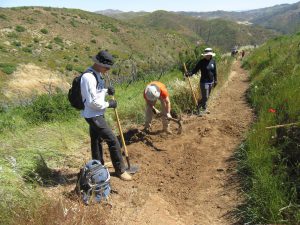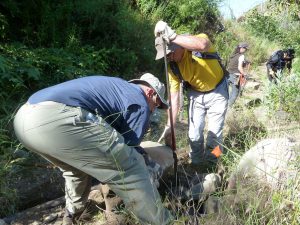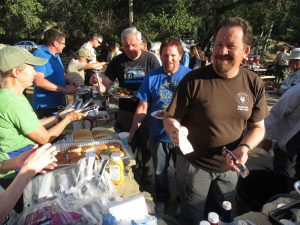April 30, 2007
The most extensive formal appeal in IMBA’s 19-year history has culminated in an agreement that will maintain widespread bicycle access in four National Forest units in Southern California. With hundreds of trail miles at stake in the Angeles, Cleveland, Los Padres and San Bernardino forests, bike advocates embarked on a lengthy appeals process to a Forest Service decision to close dozens of trails to bikes.
The decision was the culmination of five years of mountain biker participation in the Forest Service planning process. “Even when the documents and alternatives didn’t favor us, the Forest Service staff welcomed our participation and encouraged us to keep working toward a solution,” says IMBA Rep Jim Hasenauer, who began working on the issue in 2001 when the four forests first announced a joint planning process for trail management.
According to IMBA California Policy Advisor Tom Ward, strong partnerships with state and federal agencies hold the key to bike access throughout the state. “IMBA’s approach to mountain bike advocacy is to build strong relationships with land managers throughout California. We promote quality riding opportunities and work hard to create fun, environmentally sustainable trails that all users can enjoy,” says Ward.
IMBA Filed Extensive Appeal
In 2004, after three years of preliminary work, the four Southern California forest units jointly released alternative plans for forest and trail management. IMBA’s action alert generated hundreds of messages and letters urging that trails be kept open to bikes. “Although there was much that we liked in the original plan, we had concerns about some of the proposed Wilderness areas, the treatment of bicycles in ‘critical biological zones,’ and the ambiguity of language regarding bicycle use only on formally designated ‘system’ trails,” says Hasenauer.
In 2005, the forests issued a revised plan that addressed most of IMBA’s initial concerns. New Wilderness additions would have little effect on mountain bike opportunities, bikes would be allowed on trails in the “critical biological zones” unless specifically prohibited, and the Forests promised to deal with the “unofficial” trails issue with public participation, over time.
In Oct. of 2006, the San Bernardino National Forest indicated its intention to close all “non-system trails” to bicycles. “We felt that was inconsistent with the 2005 plan,” says Hasenauer. The Forest disagreed, but met with local bicyclists to inventory and keep some of those trails open. The local mountain biking community stepped up to help the Forest identify important trails for mountain bikes and the Forest agreed to delay the closure.
At the same time, Hasenauer worked with fellow IMBA Rep Daniel Greenstadt, IMBA’s Gary Sprung (then Senior Policy Adviser, now an independent contractor) and Washington-based policy advisor Kirk Bailey to develop an official appeal. “The appeal was the most extensive public participation document that IMBA has ever developed,” says Hasenauer. “Most appeals are quickly disqualified, but ours went forward.”
Meetings Lead to Withdrawal of Appeal
In Nov. 2006, Hasenauer met with the Southern California Forest Supervisors and staff. “We agreed that the three other forests had a more reasonable approach and we’re in fact, a more reasonable interpretation of the new plans,” says Hasenauer. “We agreed that there would need to be a process and a Forest Order before trails were closed. Bicyclists could continue to ride such trails unless specifically prohibited. They also indicated that generally if non-classified trails were to be closed, they should be closed to all users.” That understanding resulted in the December 2006 withdrawal of IMBA’s appeal.
“This is a great example of how steadfast advocacy inside public participation processes can save trails. IMBA is quite satisfied with the resolution and we look forward to working with the Forest Service on trail management issues again,” says IMBA Government Affairs Director Jenn Dice.
For more information, Contact: Mark Eller, Communications Director, markeller@imba.com, 303-545-9011


 Three main questions were asked by the NPS including: what are your hopes and expectations for the future of National Parks; what role should the National Parks play in the lives of Americans and visitors from around the world; and what projects and programs would you like to see completed. Despite these questions, a handful of anti-mountain bikers were in attendance suggesting that mountain bikes not be a part of the future of our National Parks. Fortunately, CORBA board members Jeff, Louisa and Gary were there to add balance to the discussion, provide input and also note how successful multi-use trails are in our local National Parks (i.e., Cheeseboro) as well as the amazing experiences that are available at parks such as Joshua Tree and Chaco Canyon.
Three main questions were asked by the NPS including: what are your hopes and expectations for the future of National Parks; what role should the National Parks play in the lives of Americans and visitors from around the world; and what projects and programs would you like to see completed. Despite these questions, a handful of anti-mountain bikers were in attendance suggesting that mountain bikes not be a part of the future of our National Parks. Fortunately, CORBA board members Jeff, Louisa and Gary were there to add balance to the discussion, provide input and also note how successful multi-use trails are in our local National Parks (i.e., Cheeseboro) as well as the amazing experiences that are available at parks such as Joshua Tree and Chaco Canyon.



